Geothermal Formations at Orakei Korako
The geothermal activity at Orakei Korako produces a range of very interesting formations, some of which are listed below.
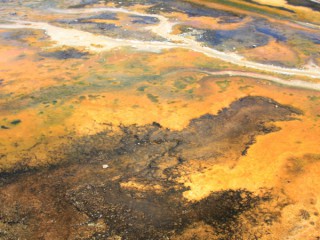 Emerald Terrace
Emerald Terrace
The first sinter terrace encountered at Orakei Korako is called the Emerald Terrace. The wet surface of the terrace displays an impressive array of colourful microbial mats. The mats are made up of many thousands of tiny microbes or microscopic single-celled organisms, which thrive in the warm water that flows over the sinter terrace.
Emerald Terrace is dominated by orange "bubble mats". These living microbes form orange coloured microbial mats when the water temperature is between 35-59°C. On Emerald Terrace, the water temperature where these orange mats form is usually around 45°C with a pH around 7.6. the large bubbles you see are where gas has accumulated, as a result of oxygen trapped in the mat during microbial photosynthesis.
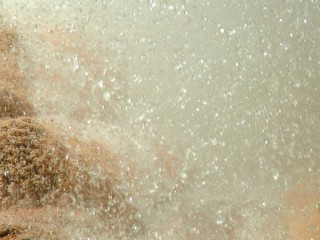 Diamond Geyser
Diamond Geyser
Diamond geyser erupts frequently and throws water up to 9 metres into the air. Water erupts in brief, explosive bursts and can last anything from several minutes to several hours. The water temperature of Diamond Geyser is between 70-90°C with a pH of 8.6 - 9.3. At the top of the sinter slope, there is a clear boiling pool, less than 1 metre in diameter.
Nodular silica sinter forms around the throat of the geyser. This is called geyserite and consists entirely of silica (like the sinter terraces). Geyserite forms where the area is repeatedly wetted by splashing and the water evaporates rapidly.
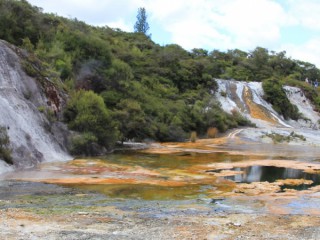 Cascade Terrace and Terracettes
Cascade Terrace and Terracettes
Silica sinter can be seen draping over the terrace face and forming sinter stalactites, or a silica terrace. Microbial mats which thrive in the warm waters from a colourful display of orange and green cascading down the sinter slope.
On the northern side of Rainbow Terrace, micro-terracettes have forms. Microscope photos show these micro-terraces are composed of microbes in the brown/black mat. The microbes grow vertically as closely-packed pillar-like filamentous structures. They live where the temperature is less than 35°C and the fluid flow is shallow.
Hochstetter's Pool
This pool is named after Dr. Ferdinand von Hochstetter, an Austrian geologist who visited here in 1859 and first described the thermal activity at Orakei Korako.
Hochstetter's Pool is a 5 metre round pool with vertical sides, which discharges water onto Rainbow Terrace. The pool is surrounded by yellow, orange and green microbial mats.
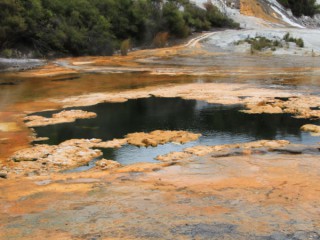 Map of Africa
Map of Africa
The Map of Africa is about 70 square metres in size and is divided into two basins by a low ridge. The water temperature ranges between 58-68°C with a pH of 6.8 - 7.6.
There are two easy clues that give us a reasonably accurate indication that the water in this pool is being fed solely by thermal springs upstream of the pool and not by springs within the pool.
- No obvious upwelling of spring water is present
- Flow into the pool roughly equals the amount of flow out of the pool, also indicating that the pool is probably not fed by an independent spring within the pool.
At the point of discharge, the water flow is fast. Where the flow rate is more rapid, the green bubble mats stretch and elongate as a result of the increased flow.
The Lookout
To the west (towards the lake), below the lookout and amongst the trees, is a small hydrothermal eruption crater. This erupted suddenly and without warning in January 2001, throwing steam, water and mud 20 metres into the air and creating an impressive mudslide into the lake. The entire eruption lasted five minutes. In the months following, the crater filled with clear blue water.
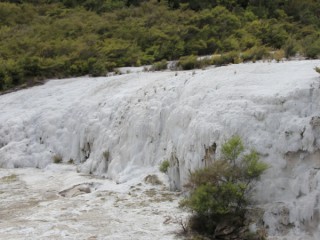 Golden Fleece Terrace
Golden Fleece Terrace
Golden Fleece Terrace has abundant old silicified plant material which is easily seen in the sinter. In the past, reed-like grasses grew on this terrace. When the grasses died they became entombed by the silica and fossilised in the sinter.
New microbial communities are currently establishing themselves on Golden Fleece Terrace. These colourful microbial mats started growing in early September 2001 when water started flowing over this part of the terrace once again, providing favourable conditions for communities of microbes.
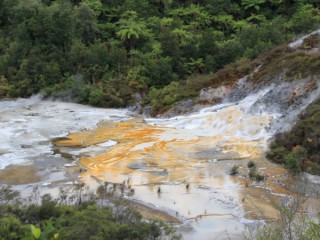 Artist's Palette
Artist's Palette
Artist's Palette is an almost level, 10,000m2 silica sinter terrace. Silica sinter on Artist's Palette fills an old hydrothermal eruption crater that formed between 8,000 - 14,000 years ago. Remnants of the hydrothermal crater wall form steep steaming ridges.
Today the white silica sinter terrace is approximately 150 metres long and varies from 35 - 115 metres in width. Clear, blue, alkali chloride water forms pools, springs and geysers. Clear blue pools occur at or below the water table.
Steaming ground is also a surface discharge feature on this terrace. The steaming ground visible occurs above the water table.
The amount of water discharging from the springs onto the sinter terrace fluctuates continually. Water levels are at times below the top of the terrace, while at other times a large portion of the sinter terrace is covered by a shallow flow of hot alkali chloride water.
The geysers on the terrace erupt at irregular intervals.
A new geyser started erupting in 2001. Sinter is depositing on the slopes around this geyser and a well formed sloping sinter apron cascades down towards the terrace. Colonies of colourful microbial mats have established themselves along the pathways of the water flowing down the sinter apron.
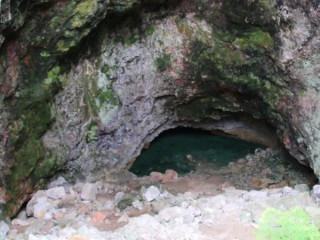 Ruatapu Cave
Ruatapu Cave
Ruatapu cave is also known as Aladdin's Cave. Ruatapu cave descends steeply into volcanic tuff. Tuff is consolidated ash deposited from a volcanic eruption, this one being from an eruption approximately 100,000 years ago.
The cave extends 45 metres into the surrounding rock and descends for 23 metres. The small pool at the base of the cave is known as Waiwhakaata or 'The Pool of Mirrors'. Waiwhakaata pool waters are an acidic mixture of acid-sulphate-chloride with a pH between 2.1 - 3.0 and water temperature around 44°C.
Steam and hydrogen sulphide gas (H2S) rise from the pool surface. The H2S dissolves in the steam. When the steam cools and condenses, an acidic condensate is formed, which reacts with the tuff to produce alteration minerals seen on the walls above the pool.
There are two ideas as to the formation of Ruatapu cave. One theory is that the cave is a hydrothermal eruption crater where heat and steam pressure under the tuff became so great it erupted, forming the cave. When a hydrothermal eruption happens, numerous pieces of rock are thrown out of the create and rest around its mouth. These rocks are called hydrothermal eruption breccias. However, no hydrothermal eruption breccia has been found at the mouth of Ruatapu cave.
The other way the cave may have formed is by dissolution along joints or rock fractures. Image a giant fumarole producing acidic condensate. The acidic condensate eats into the overlying tuff along rock joints and fractures, dissolving it. The tuff then collapses, forming a cave. Because you can see rock alteration occurring directly above the acidic pool, it seems likely that this cave is a dissolution crater.
The Chemistry and Microbiology at Orakei Korako »





